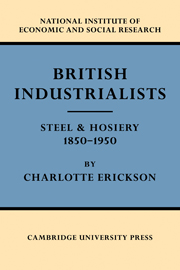Book contents
- Frontmatter
- Contents
- LIST OF TABLES
- Foreword
- Introduction
- I SCOPE OF THE INQUIRY
- II SOCIAL ORIGINS OF THE STEEL MANUFACTURERS
- III CAREERS OF THE STEEL MANUFACTURERS
- IV SOCIAL ORIGINS OF THE NOTTINGHAM HOSIERS
- V CAREERS OF THE HOSIERY MANUFACTURERS
- VI THE INTRODUCTION OF NEW TECHNIQUES IN STEEL-MAKING
- VII HOSIERY INNOVATORS
- VIII THE PUBLIC COMPANY
- Appendix A Selection of firms
- Appendix B List of firms included in steel study
- Appendix C Selection of men for steel study
- Appendix D The hosiery samples
- Appendix E Classification of fathers' occupations
- Appendix F Notes on comparisons with Population Census
- Appendix G Education
- Appendix H Marriages
- Appendix I Careers
- Appendix J Public company tables
- List of Principal Works Cited
- Index of names
- Index of companies
- General index
- PUBLICATIONS OF THE NATIONAL INSTITUTE OF ECONOMIC AND SOCIAL RESEARCH
I - SCOPE OF THE INQUIRY
Published online by Cambridge University Press: 07 October 2011
- Frontmatter
- Contents
- LIST OF TABLES
- Foreword
- Introduction
- I SCOPE OF THE INQUIRY
- II SOCIAL ORIGINS OF THE STEEL MANUFACTURERS
- III CAREERS OF THE STEEL MANUFACTURERS
- IV SOCIAL ORIGINS OF THE NOTTINGHAM HOSIERS
- V CAREERS OF THE HOSIERY MANUFACTURERS
- VI THE INTRODUCTION OF NEW TECHNIQUES IN STEEL-MAKING
- VII HOSIERY INNOVATORS
- VIII THE PUBLIC COMPANY
- Appendix A Selection of firms
- Appendix B List of firms included in steel study
- Appendix C Selection of men for steel study
- Appendix D The hosiery samples
- Appendix E Classification of fathers' occupations
- Appendix F Notes on comparisons with Population Census
- Appendix G Education
- Appendix H Marriages
- Appendix I Careers
- Appendix J Public company tables
- List of Principal Works Cited
- Index of names
- Index of companies
- General index
- PUBLICATIONS OF THE NATIONAL INSTITUTE OF ECONOMIC AND SOCIAL RESEARCH
Summary
The aims of this chapter are to outline briefly the definitions used in deciding which businessmen were to be included in the study; to discuss the main sources from which information was culled; and, finally, to indicate what proportion of the men we set out to study could, in fact, be included in the final figures. For those who are interested in more detail on these points, references are given to the Appendices.
DEFINITIONS OF THE INDUSTRIES
In order to qualify as steel manufacturers for the purposes of this study, a firm had to be an ingot-maker producing steel by either the Bessemer or the open-hearth process. This definition presented some difficulties. It was not easy to discover the names of firms which are, or have been, ingot-makers; and the study does not in fact include all of them. There were several reasons for adopting this definition in spite of its problems.
In the first place, the study would thus be limited to a branch of heavy industry which introduced particular important technological innovations during the third quarter of the nineteenth century. The heavy steel industry was begun within the time limits of the study, and one wanted to exclude firms which continued to make only pig-iron or wrought iron, since they had not experienced the potentially invigorating and revolutionary effects of this great change.
- Type
- Chapter
- Information
- British IndustrialistsSteel and Hosiery 1850–1950, pp. 1 - 8Publisher: Cambridge University PressPrint publication year: 1959



